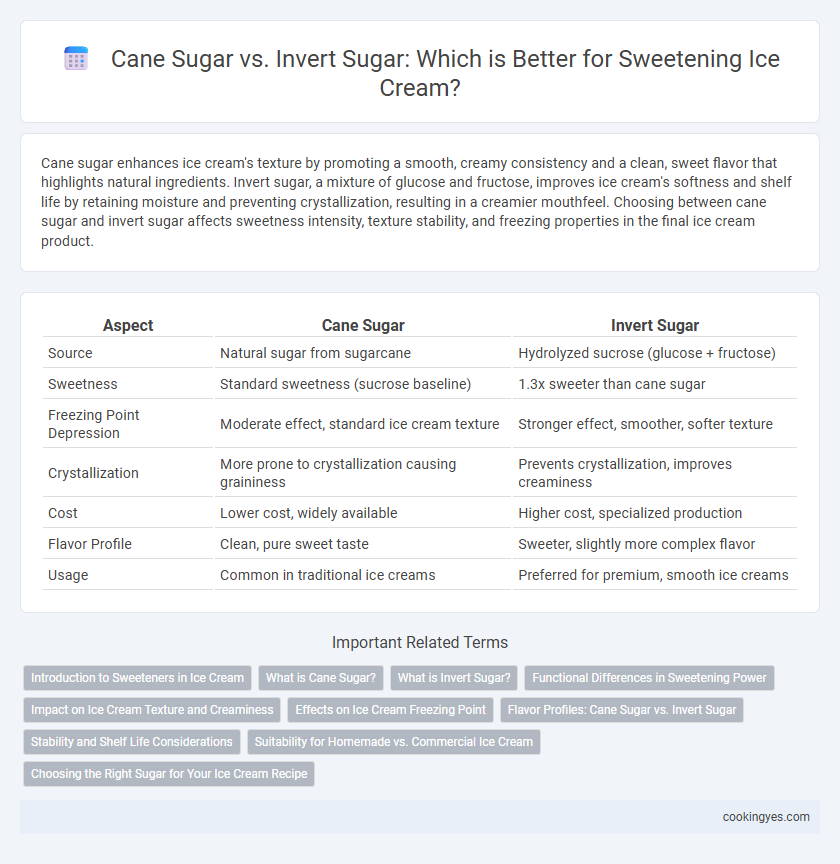Cane sugar enhances ice cream's texture by promoting a smooth, creamy consistency and a clean, sweet flavor that highlights natural ingredients. Invert sugar, a mixture of glucose and fructose, improves ice cream's softness and shelf life by retaining moisture and preventing crystallization, resulting in a creamier mouthfeel. Choosing between cane sugar and invert sugar affects sweetness intensity, texture stability, and freezing properties in the final ice cream product.
Table of Comparison
| Aspect | Cane Sugar | Invert Sugar |
|---|---|---|
| Source | Natural sugar from sugarcane | Hydrolyzed sucrose (glucose + fructose) |
| Sweetness | Standard sweetness (sucrose baseline) | 1.3x sweeter than cane sugar |
| Freezing Point Depression | Moderate effect, standard ice cream texture | Stronger effect, smoother, softer texture |
| Crystallization | More prone to crystallization causing graininess | Prevents crystallization, improves creaminess |
| Cost | Lower cost, widely available | Higher cost, specialized production |
| Flavor Profile | Clean, pure sweet taste | Sweeter, slightly more complex flavor |
| Usage | Common in traditional ice creams | Preferred for premium, smooth ice creams |
Introduction to Sweeteners in Ice Cream
Cane sugar and invert sugar both serve as primary sweeteners in ice cream, impacting texture and sweetness perception. Cane sugar, a natural sucrose, contributes to freezing point depression, enhancing creaminess and scoopability, while invert sugar, a blend of glucose and fructose, retains moisture better and inhibits crystallization for smoother mouthfeel. Selecting the right sweetener influences ice cream's viscosity, flavor balance, and storage stability.
What is Cane Sugar?
Cane sugar, derived from sugarcane, is a natural sweetener commonly used in ice cream for its clean, sweet flavor and ability to enhance texture and mouthfeel. It consists mainly of sucrose, which provides a balanced sweetness and helps control ice crystallization, contributing to a smoother, creamier consistency. Unlike invert sugar, cane sugar does not retain moisture as effectively, which can influence the ice cream's overall softness and shelf life.
What is Invert Sugar?
Invert sugar is a liquid sweetener made by splitting sucrose into glucose and fructose through hydrolysis, enhancing ice cream's sweetness and texture. Compared to cane sugar, invert sugar provides better moisture retention, resulting in a smoother, creamier consistency and slower ice crystallization. Its higher solubility and hygroscopic nature make it ideal for improving shelf life and preventing ice cream from becoming grainy.
Functional Differences in Sweetening Power
Cane sugar and invert sugar differ significantly in sweetening power, impacting ice cream texture and flavor. Cane sugar, primarily sucrose, provides a moderate sweetness and contributes to ice cream's firmness by controlling freezing point. Invert sugar, a mixture of glucose and fructose, is approximately 20-30% sweeter than cane sugar, enhancing smoothness and reducing crystallization for a creamier mouthfeel.
Impact on Ice Cream Texture and Creaminess
Cane sugar contributes to a smoother texture and enhances the creaminess of ice cream by crystallizing less and providing a clean, sweet flavor. Invert sugar, a mixture of glucose and fructose, improves moisture retention and prevents ice crystal formation, leading to a softer, more scoopable texture. The choice between cane sugar and invert sugar significantly affects the ice cream's mouthfeel, melting rate, and overall sensory experience.
Effects on Ice Cream Freezing Point
Cane sugar increases the freezing point depression in ice cream, resulting in a softer texture by lowering the mixture's freezing temperature. Invert sugar, composed of glucose and fructose, has a greater effect on freezing point depression due to its higher molecular sweetness and better solubility, producing smoother ice cream with reduced iciness. Choosing between cane sugar and invert sugar significantly influences ice cream's freezing point, texture, and overall mouthfeel by altering the ice crystal formation during freezing.
Flavor Profiles: Cane Sugar vs. Invert Sugar
Cane sugar imparts a clean, classic sweetness with subtle molasses notes that enhance natural flavors in ice cream without overpowering them. Invert sugar, a mixture of glucose and fructose, offers a smoother, more intense sweetness and improves moisture retention, yielding a creamier texture and prolonged flavor release. The choice between cane sugar and invert sugar directly influences the ice cream's flavor complexity and mouthfeel, with invert sugar promoting a richer, more balanced sweetness profile.
Stability and Shelf Life Considerations
Cane sugar offers better crystallization control in ice cream, contributing to a stable texture and extended shelf life by preventing ice crystal growth. Invert sugar, with its higher moisture retention and hygroscopic properties, enhances softness but may reduce shelf stability by promoting microbial growth if not properly formulated. Balancing these sugars optimizes ice cream stability and longevity by leveraging cane sugar's shelf life benefits and invert sugar's texture improvement.
Suitability for Homemade vs. Commercial Ice Cream
Cane sugar offers a straightforward, natural sweetness ideal for homemade ice cream, providing a clean flavor and easy availability. Invert sugar, a blend of glucose and fructose, enhances commercial ice cream by improving texture, reducing crystallization, and extending shelf life. While cane sugar suits small-batch recipes, invert sugar's superior humectant properties make it essential for large-scale production with consistent quality.
Choosing the Right Sugar for Your Ice Cream Recipe
Cane sugar contributes a clean, sweet flavor and helps achieve a smooth texture by preventing crystallization in ice cream, making it ideal for traditional recipes. Invert sugar, containing glucose and fructose, offers superior moisture retention and softness, enhancing scoopability and extending shelf life. Selecting the right sugar depends on desired texture, sweetness level, and storage conditions to optimize ice cream quality.
Cane sugar vs Invert sugar for sweetening ice cream Infographic

 cookingyes.com
cookingyes.com